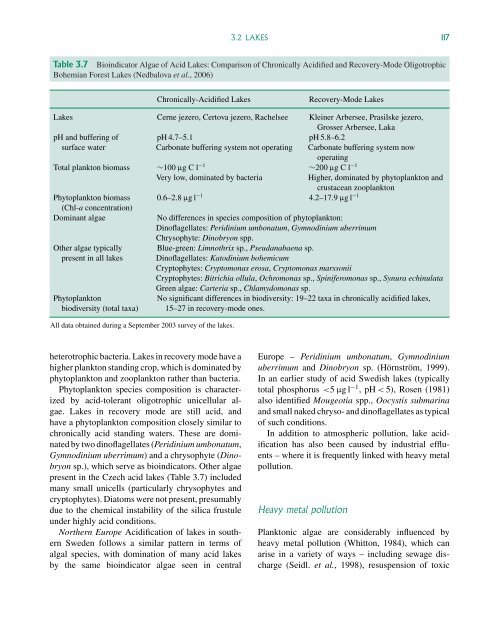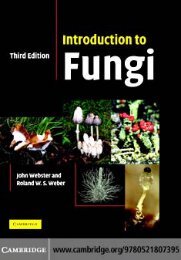116 3 ALGAE AS BIOINDICATORSTable 3.6Organic Pollution at Selected Sites: Application of Palmer’s (1969) IndicesAquatic SiteRecorded GeneraPollutionRatingHigh Organic PollutionSewage stabilization pond Ankistrodesmus, Chlamydomon<strong>as</strong>, Chlorella, 25 Clear supporting evidenceCyclotella, Euglena, Micractinium,Nitzschia, Phacus, ScenedesmusGreenville Creek, Ohio Euglena, Nitzschia, Oscillatoria., Navicula, 18 ProbableSynedraGr<strong>and</strong> Lake, Ohio Anacystis, Ankistrodesmus, Melosira,13 No evidenceNavicula, Scenedesmus, SynedraLake Salinda, Indiana Chlamydomon<strong>as</strong>, Melosira, Synedra 7 No organic enrichmentData from Palmer (1969) for four sites in the United States. See text for calculation of pollution rating.15–24 at different sampling sites indicating moderateto high levels of organic pollution. Care shouldbe taken in applying this index, since many sites withhigh organic pollution (e.g. soluble sewage organics)also have high inorganic nutrients (phosphates,nitrates), <strong>and</strong> algae characteristic of such sites aretypically tolerant to both.In addition to the general application of Palmer’sindex using a wide range of algal groups, the indexmay also be more specifically applied to benthicdiatoms in the <strong>as</strong>sessment of river water quality (Section3.4.5).AcidityAcidity becomes an important <strong>as</strong>pect of lake waterquality in two main situations – naturally occurringoligotrophic waters <strong>and</strong> in c<strong>as</strong>es of industrial pollution.Algal bioindicators have been important formonitoring lake pH change both in terms of lakesediment analysis (fossil diatoms, Section 3.2.2) <strong>and</strong>contemporary epilimnion populations – see below.Oligotrophic waters The tendency for oligotrophiclakes to be slightly acid h<strong>as</strong> already beennoted in relation to inorganic nutrient status (bioindicatorspecies), <strong>and</strong> for this re<strong>as</strong>on many algae typicalof low nutrient waters – including various desmids<strong>and</strong> species of Dinobryon (Table 3.3) – are also tolerantof acidic conditions. Acidic, oligotrophic waterstend to be low in species diversity. In a revised cl<strong>as</strong>sificationof British lakes proposed by Duker <strong>and</strong>Palmer (2009), naturally acid lakes include highlyacid bog/heathl<strong>and</strong> pools (group A), acid moorl<strong>and</strong>pools <strong>and</strong> small lakes (group B) <strong>and</strong> acid/slightly acidupl<strong>and</strong> lakes (group C).Industrial acidification of lakes Industrial atmosphericpollution during the l<strong>as</strong>t century led to aciddeposition <strong>and</strong> acidification of lakes in various partsof central <strong>and</strong> northern Europe.Central Europe In Central Europe, regional emissionsof S (SO 4 )<strong>and</strong> soluble inorganic N (NO 3 ,NH 4 )compounds reached up to ∼280 mmol m −2 year −1between 1940 <strong>and</strong> 1985, then declined by ∼80%<strong>and</strong> ∼35% respectively during the 1990s (Kopaceket al., 2001). This atmospheric deposition led to acidcontamination of catchment are<strong>as</strong> <strong>and</strong> the resultingacidification of various Central European mountainlakes, including a group of eight glacial lakes in theBohemian Forest of the Czech Republic (Vrba et al.,2003; Nedbalova et al., 2006).Studies by Nedbalova et al. (2006) on chronicallyacidified Bohemian Forest lakes have demonstratedsome recovery from acid contamination. This is nowbeginning, about 20 years after the reversal in aciddeposition that occurred in 1985, with some lakesstill chronically acid – but others less acid <strong>and</strong> inrecovery mode (Table 3.7). Chronically-acid lakeshave low primary productivity, with low levels ofphytoplankton <strong>and</strong> zooplankton <strong>and</strong> domination by
3.2 LAKES 117Table 3.7 Bioindicator <strong>Algae</strong> of Acid Lakes: Comparison of Chronically Acidified <strong>and</strong> Recovery-Mode OligotrophicBohemian Forest Lakes (Nedbalova et al., 2006)Chronically-Acidified LakesRecovery-Mode LakesLakes Cerne jezero, Certova jezero, Rachelsee Kleiner Arbersee, Pr<strong>as</strong>ilske jezero,Grosser Arbersee, LakapH <strong>and</strong> buffering ofsurface waterpH 4.7–5.1Carbonate buffering system not operatingpH 5.8–6.2Carbonate buffering system nowTotal plankton biom<strong>as</strong>sPhytoplankton biom<strong>as</strong>s(Chl-a concentration)Dominant algaeOther algae typicallypresent in all lakesPhytoplanktonbiodiversity (total taxa)∼100 µg Cl −1Very low, dominated by bacteriaAll data obtained during a September 2003 survey of the lakes.0.6–2.8 µgl −1 4.2–17.9 µgl −1operating∼200 µg Cl −1Higher, dominated by phytoplankton <strong>and</strong>crustacean zooplanktonNo differences in species composition of phytoplankton:Dinoflagellates: Peridinium umbonatum, Gymnodinium uberrimumChrysophyte: Dinobryon spp.Blue-green: Limnothrix sp., Pseudanabaena sp.Dinoflagellates: Katodinium bohemicumCryptophytes: Cryptomon<strong>as</strong> erosa, Cryptomon<strong>as</strong> marssoniiCryptophytes: Bitrichia ollula, Ochromon<strong>as</strong> sp., Spiniferomon<strong>as</strong> sp., Synura echinulataGreen algae: Carteria sp., Chlamydomon<strong>as</strong> sp.No significant differences in biodiversity: 19–22 taxa in chronically acidified lakes,15–27 in recovery-mode ones.heterotrophic bacteria. Lakes in recovery mode have ahigher plankton st<strong>and</strong>ing crop, which is dominated byphytoplankton <strong>and</strong> zooplankton rather than bacteria.Phytoplankton species composition is characterizedby acid-tolerant oligotrophic unicellular algae.Lakes in recovery mode are still acid, <strong>and</strong>have a phytoplankton composition closely similar tochronically acid st<strong>and</strong>ing waters. These are dominatedby two dinoflagellates (Peridinium umbonatum,Gymnodinium uberrimum) <strong>and</strong> a chrysophyte (Dinobryonsp.), which serve <strong>as</strong> bioindicators. Other algaepresent in the Czech acid lakes (Table 3.7) includedmany small unicells (particularly chrysophytes <strong>and</strong>cryptophytes). Diatoms were not present, presumablydue to the chemical instability of the silica frustuleunder highly acid conditions.Northern Europe Acidification of lakes in southernSweden follows a similar pattern in terms ofalgal species, with domination of many acid lakesby the same bioindicator algae seen in centralEurope – Peridinium umbonatum, Gymnodiniumuberrimum <strong>and</strong> Dinobryon sp. (Hörnström, 1999).In an earlier study of acid Swedish lakes (typicallytotal phosphorus
















